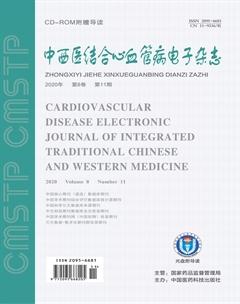颈动脉内中膜厚度及弹性定量指标对冠状动脉粥样硬化性心脏病诊断效果观察
郑芳 胡寅进 王丽

【摘要】目的 观察颈动脉内中膜厚度、弹性定量指标,对冠状动脉粥样硬化性心脏(冠心病)病诊断的效果。方法 将我院2015年7月~2018年7月区间撷取的140例疑似冠心病患者,按照病史资料进行分组处理,将所有患者分为冠状动脉粥样硬化组(n=32)、非冠心病组(n=38)、单支病变组(n=30)、多支病变组(n=40)。4组患者均接受颈动脉内中膜厚度、弹性定量指标诊断,观察组间左颈总动脉中膜厚度LIMT、左颈总动脉脉搏波传导速度LPWV、左颈总动脉硬度指数Lβ。结果 4组LIMT、LPWV、Lβ相比较,多支病变组的上述指标均明显高于其他3组,P<0.05。结论 颈动脉内中膜厚度、弹性定量指标检测,于冠心病多支病变患者中应用诊断效果理想,临床应用价值突出。
【关键词】颈动脉内中膜厚度;弹性定量指标;冠状动脉粥样硬化性心脏病
【中图分类号】R541.4 【文献标识码】A 【文章编号】ISSN.2095.6681.2020.11..02
Carotid intima-media thickness and elastic quantitative index for coronary atherosclerotic heart disease
ZHENG Fang1, HU Yin-jin1, WANG Li2
(Xiamen special service recuperation center of the army,1.Department of Radiology;
2.Rehabilitation,Fujiang Xiamen 361000,China)
【Abstract】Objective To observe the effect of carotid artery intima-media thickness and elastic quantitative index on the diagnosis of coronary atherosclerotic heart(CHD)disease.Methods 140 patients with suspected coronary heart disease(CHD)collected from July 2015 to July 2018 in our hospital were grouped according to their medical history.All patients were divided into three groups:coronary atherosclerosis group(n=32),non-coronary heart disease group(n=38),single vessel disease group(n=30),multiple vessel disease group(n=40).The carotid intima-media thickness(LIMT),left common carotid artery pulse wave velocity(LPWV)and left common carotid artery stiffness index(Lbet)were measured in all four groups.Results Compared with limt,lpwv and lβin the four groups,the above indexes in the multi vessel lesion group were significantly higher than those in the other three groups(P<0.05).Conclusion The detection of carotid intima-media thickness and elastic quantitative index is ideal for the diagnosis of coronary artery disease with multi-vessel disease.The clinical application value is outstanding.
【Key words】Carotid intima-media thickness;Quantitative quantitative index;Coronary atherosclerotic heart disease
冠狀动脉粥样硬化性心脏病,即为冠心病,指的是冠状动脉粥样硬化病变所致血管腔狭窄/阻塞,而引发的心肌缺血、缺氧/坏死的心脏病[1]。不可改变危险因素包括:性别、年龄、家族史等,临床常见体力活动、情绪激动下发生心前区疼痛表现,一般为发作性绞痛/压榨痛。本研究撷取我院近年来140例疑似冠心病患者,分析实行颈动脉内中膜厚度、弹性定量指标检测的临床价值。
1 临床数据信息、方法
1.1 临床相关数据信息
将我院2015年7月~2018年7月区间撷取的140例疑似冠心病患者,按照其病史资料分为:冠状动脉粥样硬化组32例、非冠心病组38例、单支病变组30例、多支病变组40例。冠状动脉粥样硬化组男性、女性分别为:17例、15例;年龄在45~78岁的范围,中位年龄(61.5±6.6)岁。非冠心病组男性为20例,女性为18例;年龄在48~76岁的范围,中位年龄(62.3±6.8)岁。单支病变组男性为16例,女性为14例;年龄在46~76岁的范围,中位年龄(61.1±6.4)岁。多支病变组男性为23例,女性为17例;年龄在50~72岁的范围,中位年龄(61.9±6.7)岁。4组的上述临床资料方面对比,统计结果无意义,P>0.05。

